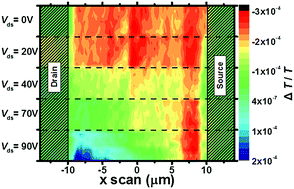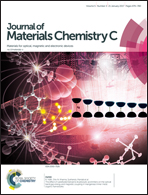Ambipolar charge distribution in donor–acceptor polymer field-effect transistors†
Abstract
Recent developments in the design and synthesis of donor–acceptor semiconducting copolymers have significantly contributed to improve the ambipolar transport properties of polymer field-effect transistors (FETs). The further development of such FETs towards real applications would greatly benefit from the knowledge of the specific charge distribution along the channel, especially in the ambipolar regime. Here we accomplish this task by adopting charge modulation spectroscopy (CMS) and microscopy (CMM), electro-optical spectroscopy techniques which allow us to probe in situ charge induced features in the transmission spectra of conjugated polymers, to study a model high mobility donor–acceptor co-polymer (DPPT-TT, poly(N-alkyldiketopyrrolo-pyrrole dithienylthieno[3,2-b]thiophene)). Thanks to the sub-micrometer spatial resolution of confocal microscopy, we are able to isolate the specific contribution of channel and electrode regions which are superimposed in the macroscopic CMS spectra, thus allowing the mapping of hole and electron distributions across the active channel in both unipolar and ambipolar operating regimes. Our findings illustrate the use of a local probe in charge-modulation experiments to correctly assign spectral features and to determine the distributions of positive and negative charge carriers in an operating device, which has relevant implications on the understanding of the nature of charge transport in high-mobility ambipolar semiconducting polymers.



 Please wait while we load your content...
Please wait while we load your content...